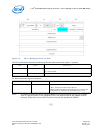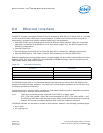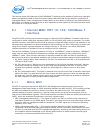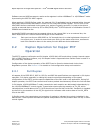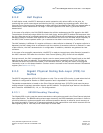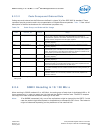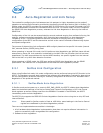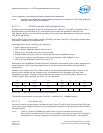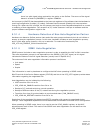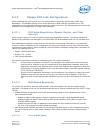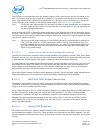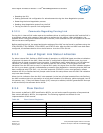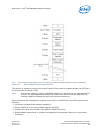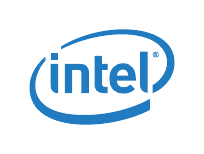
Intel
®
82575EB Gigabit Ethernet Controller — Auto-Negotiation and Link Setup
Intel
®
82575EB Gigabit Ethernet Controller 324632-003
Software Developer’s Manual and EEPROM Guide Revision: 2.1
246 January 2011
9.3 Auto-Negotiation and Link Setup
The method for configuring the link between two link partners is highly dependent on the mode of
operation as well as the functionality provided by the specific physical layer device (PHY or SerDes). For
SerDes mode, the 82575 provides the complete 802.3z PCS function. For internal PHY mode, the PCS
and Auto-Negotiation functions are maintained within the PHY. For SGMII mode, the 82575 supports
the SGMII link Auto-Negotiation process, whereas the link Auto-Negotiation is done by the external
SGMII PHY.
Configuration of the link can be accomplished by several methods ranging from software’s forcing link
settings, software-controlled negotiation, MAC-controlled auto-negotiation, to Auto-Negotiation
initiated by a PHY. The following sections describe processes of bringing the link up including
configuration of the 82575 and the transceiver as well as the various methods of determining duplex
and speed configuration.
The process of determining link configuration differs slightly based on the specific link mode (internal
PHY, external SerDes, SGMII) being used.
When operating in internal PHY mode, the PHY performs Auto-Negotiation per 802.3ab clause 40 and
extensions to clause 28. Link resolution is obtained by the MAC from the PHY after the link has been
established. The MAC accomplishes this via the MDIO interface, via specific signals from the internal
PHY to the MAC or by MAC auto detection functions.
When operating in SGMII mode, the PCS layer performs SGMII Auto-Negotiation per the SGMII
specification. The external PHY is responsible for the Ethernet auto-negotiation process.
9.3.1 SerDes Link Configuration
When using SerDes link mode, link mode configuration can be performed using the PCS function in the
82575. The hardware supports both hardware and software Auto-Negotiation methods for determining
the link configuration as well as allowing for manually configuration to force the link. Hardware Auto-
Negotiation is the preferred method.
9.3.1.1 SerDes Mode Auto-Negotiation
In SerDes mode and at power up or reset via GIO_PWR_GOOD, the 82575 initiates Auto-Negotiation
based on the default settings in the Device Control and Transmit Configuration or PCS Link Control
Word registers as well as settings read from the EEPROM. If enabled in the EEPROM, the 82575
immediately performs Auto-Negotiation.
The 82575 fully supports the IEEE 802.3z Auto-Negotiation function when using the on-chip PCS and
internal SerDes.
Note: Since speed for SerDes modes is fixed at 1000 Mb/s, speed settings in the Device Control
register are unaffected by the Auto-Negotiation process.
There are two implementations accessible in the design:
1. A full hardware Auto-Negotiation implementation that does not require software intervention in
order to successfully reach a negotiated link configuration.
2. Software driven negotiation.





